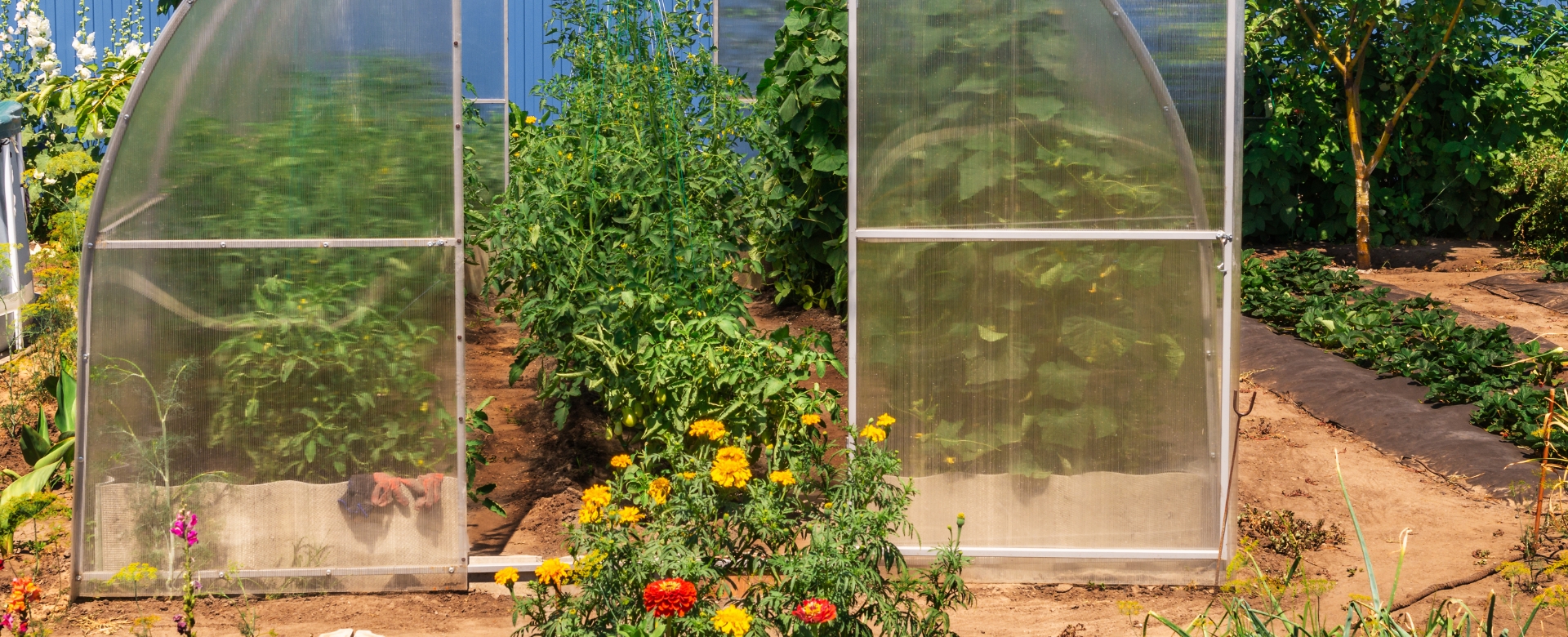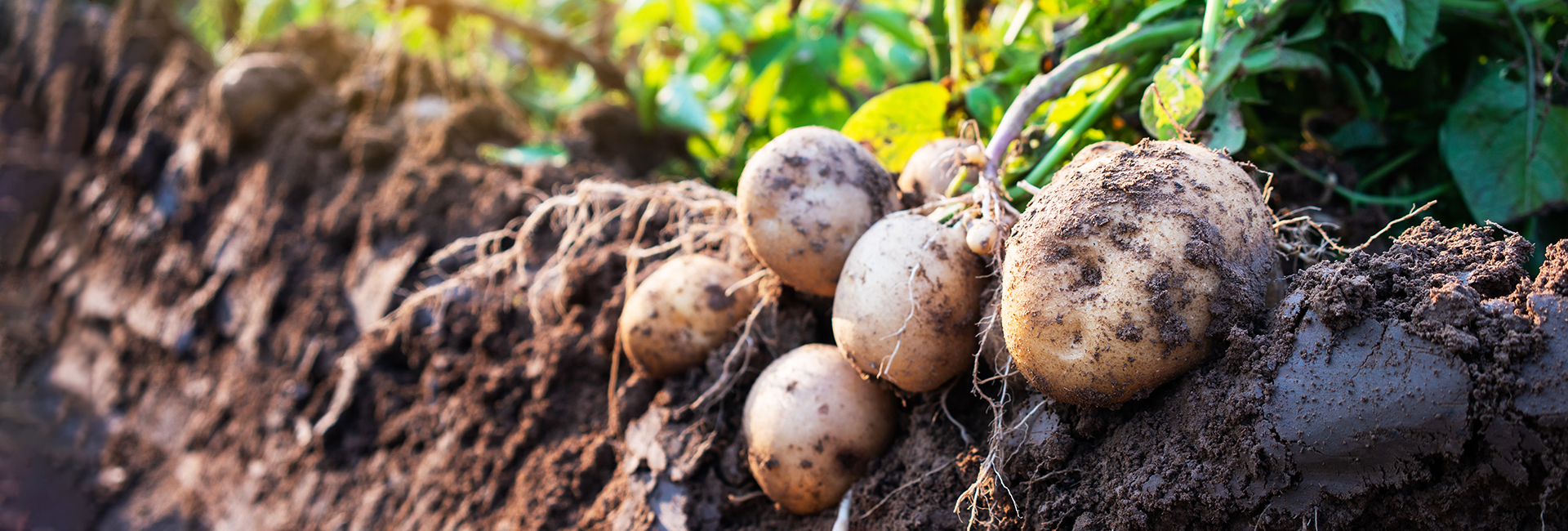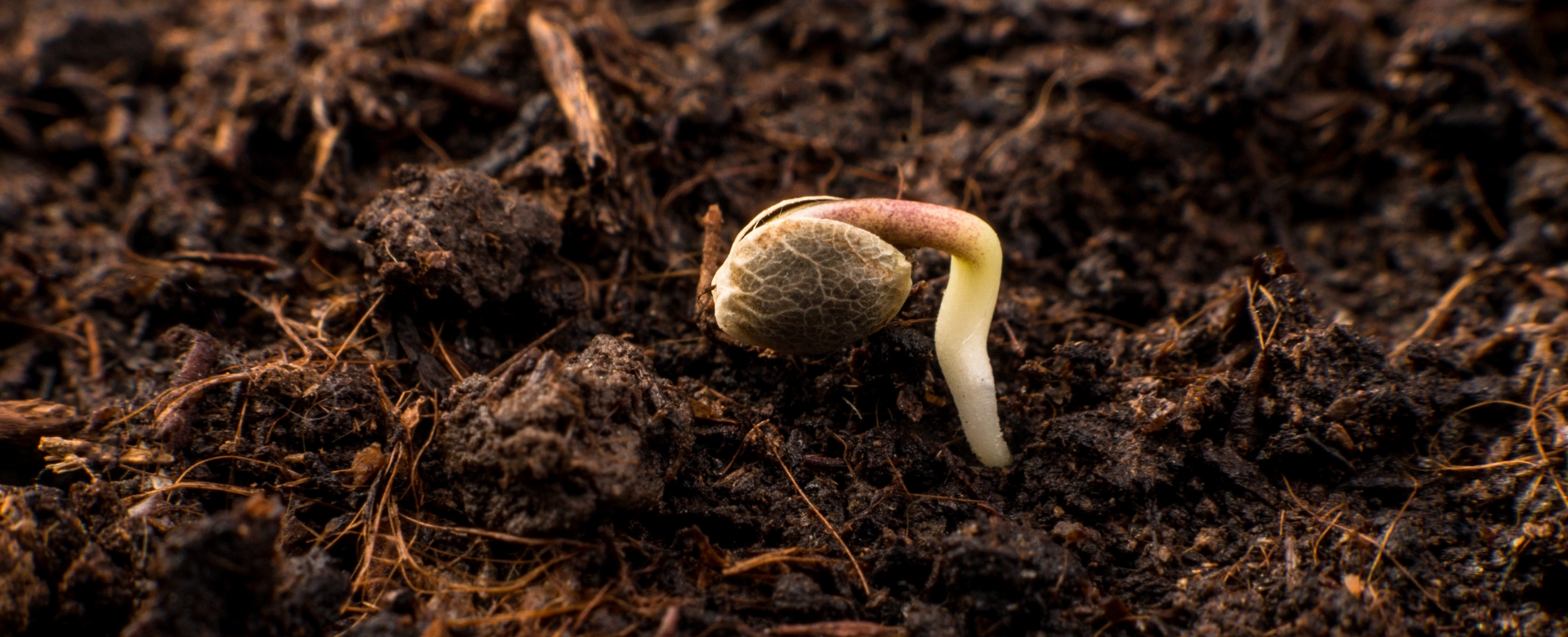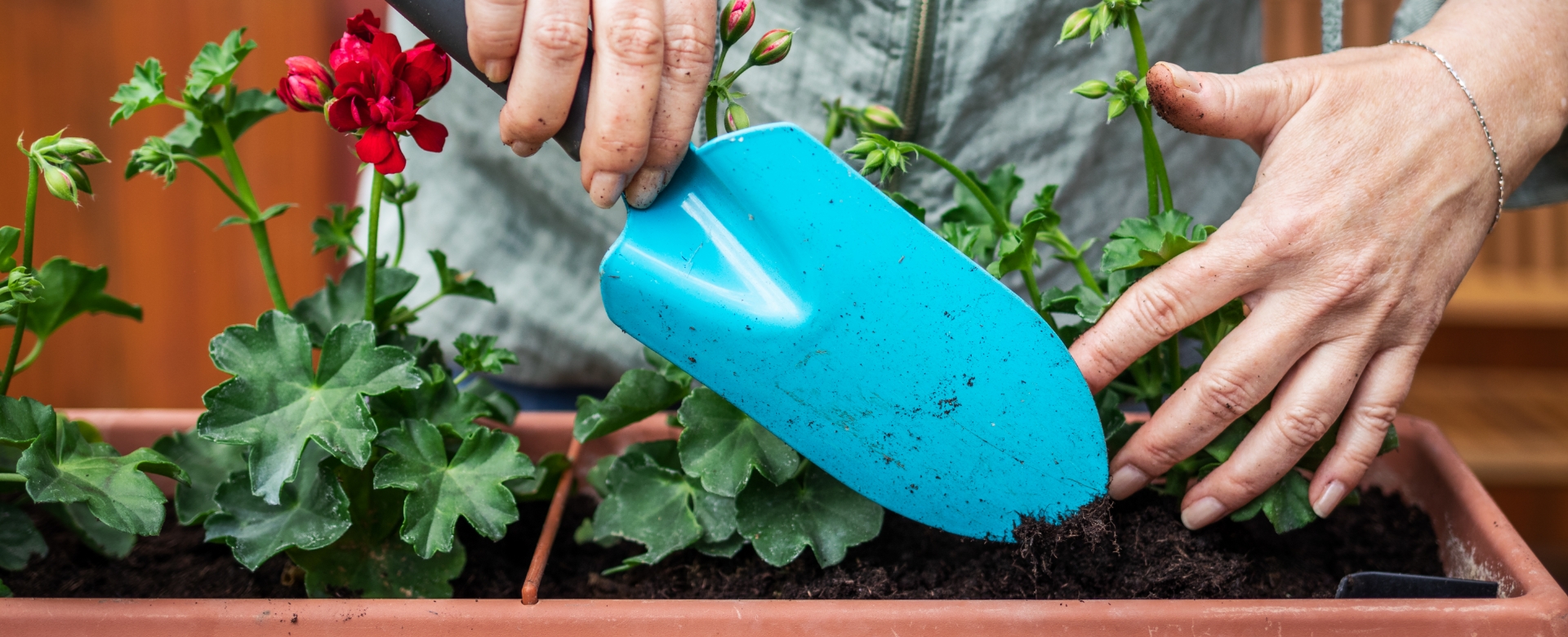I’ve been gardening for about 10 years, and I thought I knew quite a bit. But that all changed when I tried greenhouse gardening.
There are plenty of similarities between greenhouse gardening and outdoor gardening. You still need to use quality soil, water consistently, and get your plants the optimal amount of sunlight.
However, with greenhouse gardening, there are two new variables you’ll need to consider: Temperature control and humidity.
Outdoors, there’s not a lot you can do about temperature and humidity. But in the greenhouse, you have exacting control over them. To be successful, you’ll need to learn how this affects your growing season in the greenhouse.
Want to try greenhouse gardening? This guide outlines every you need to start: Key benefits, how to site your greenhouse, cheap greenhouse ideas, and the key differences between gardening in a greenhouse vs. outdoors.
Is Greenhouse Gardening Right for You?
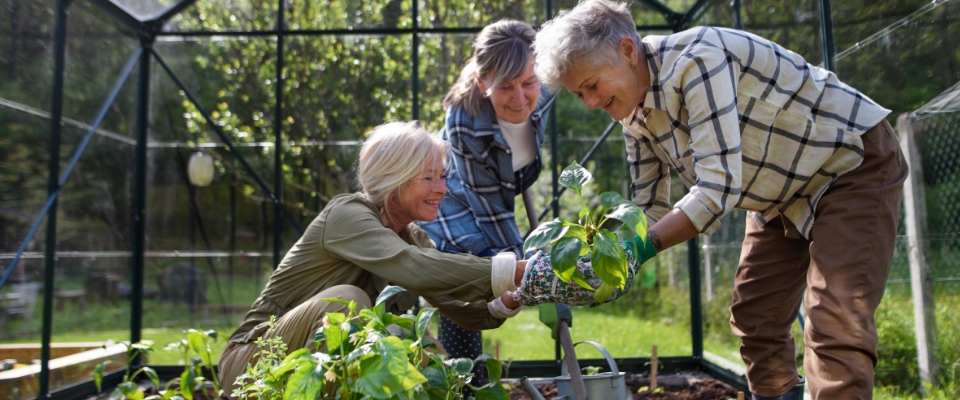
Are you serious about gardening? Do you want to grow more, start more plants indoors, or compensate for a colder climate?
If yes, then a greenhouse might be a welcome addition to your garden.
For starters, a greenhouse provides some key benefits:
- Get started earlier in the season and harvest earlier
- Extend the growing season into fall
- Protection from pests (especially deer, rodents and rabbits!)
- Greater control over growing conditions (a wet spring is not a problem in the greenhouse)
However, you might want to reconsider if you’re not committed to using your greenhouse. Greenhouse gardening, for example, takes a little bit more in terms of time, and not to mention the expense of the greenhouse itself.
Fortunately, there are some low-cost ways to get started. And that makes greenhouse gardening accessible to all.
Greenhouse Costs: What Type Do You Want to Try?
The biggest hurdle to overcome with greenhouse gardening is the cost.
According to Lawn Love, the average cost of a residential greenhouse is $5 to $30 per square foot. For a 500 square foot greenhouse, you’re looking at an investment of $2500 to $15000.
However, there are a lot of DIY and budget-friendly options for greenhouses. The most common backyard greenhouse types are:
- Lean-to: Saves space by utilizing an existing wall, simplifying construction. Great for smaller areas.
- Kit: Super convenient! Pre-cut and drilled parts with instructions for easy assembly. Lots of size, style, and material options.
- Freestanding: Independent structures offering flexibility in placement and size. More expensive and complex to build than lean-to options.
Additionally, if you aim to grow year-round (which requires heat and lighting for winter greenhouse gardening ), this is another added cost.
Budget-Friendly DIY Greenhouse Ideas
Here are some cost-effective ways to set up a greenhouse garden:
- Cold frame: A cold frame is a simple, low-cost option that provides a basic level of protection for your plants. It’s essentially a bottomless box with a transparent top that allows sunlight in and protects plants from frost and wind. You might also consider a DIY lean-to greenhouse.
- Plastic sheeting: You can use inexpensive plastic sheeting to cover a frame made from recycled materials. Just be sure to choose UV-resistant plastic that will hold up to the sun. Make sure there’s ventilation to avoid overheating.
- Portable greenhouses: These are small, temporary greenhouses that are relatively inexpensive and easy to set up. Prices typically range from $50 to $150 depending on size and features.
- Mini greenhouses: These are even smaller than portable greenhouses and are ideal for starting seeds or protecting young plants. Prices typically range from $30 to $70. My first greenhouse was a small standup, multi-shelf greenhouse.
Greenhouse Basics: Location, Ventilation and Temperature
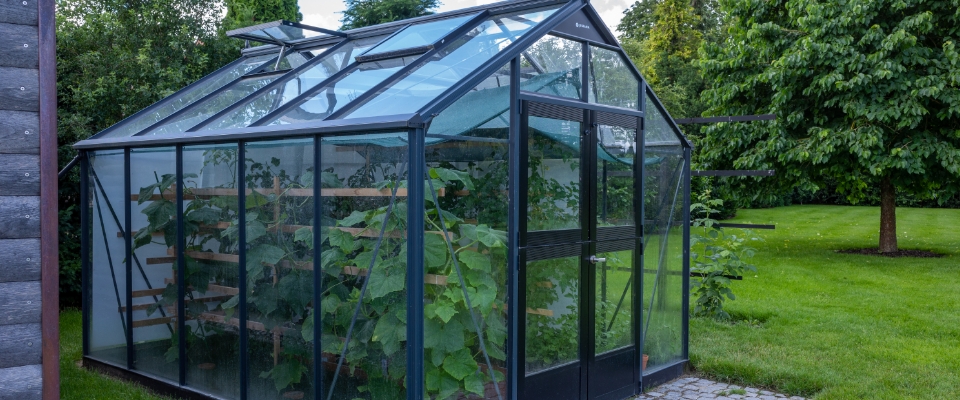
Start your greenhouse garden project off on the right foot. Focus on these two factors that can make or break your project:
1. Siting Your Greenhouse for Success
Sunlight is king in the greenhouse world! To maximize plant growth and minimize the need for supplemental lighting, consider these golden rules for greenhouse placement:
- East-West Orientation: This is the ideal setup. When your greenhouse runs east to west, it captures the most sunlight throughout the day as the sun travels across the sky.
- Sunlight Needs: Choose a location that receives at least 6 hours of direct sunlight daily, especially during the colder months. Avoid areas with constant shade from buildings or trees.
- Avoiding the Chill: Don’t place your greenhouse in low-lying areas where cold air settles. This can make temperature control more challenging, especially in winter.
- Wind Protection: While good air circulation is important, consider wind exposure. If your area experiences strong winds, position the greenhouse with the long side facing away from the prevailing winds for better stability.
2. Ventilation Basics (Temp & Humidity Control)
Greenhouse gardening is all about controlling temperatures. You don’t want the greenhouse to get hot or too humid. That’s where problems begin.
This was something that I had to learn, as temperatures inside the greenhouse can be 5 to 30 degrees higher than they are outdoors.
Here are some key ideas about greenhouse ventilation:
- Temperature Control: Greenhouses trap heat from the sun, which is great for extending the growing season. But without ventilation, temperatures can quickly soar to unhealthy levels for plants. Proper ventilation allows hot air to escape and cooler air to enter, keeping things comfortable for your plants.
- Humidity Management: Greenhouse air can become very humid, especially during transpiration (plant sweating). This creates ideal conditions for fungal diseases. Ventilation helps remove excess moisture and promotes air circulation, reducing the risk of disease outbreaks.
- Fresh Air Exchange: Plants need fresh air just like we do! Ventilation brings in carbon dioxide (CO2) which plants use for photosynthesis, the process that fuels their growth. In exchange, stale air is expelled, ensuring a healthy environment for your greenhouse plants to thrive.
The easiest way is with vents. You’ll want to mix high vents (to release hot air) and low vents (to draw in cooler air) for the best results.
Gardening in a Greenhouse vs Outdoors: Key Differences
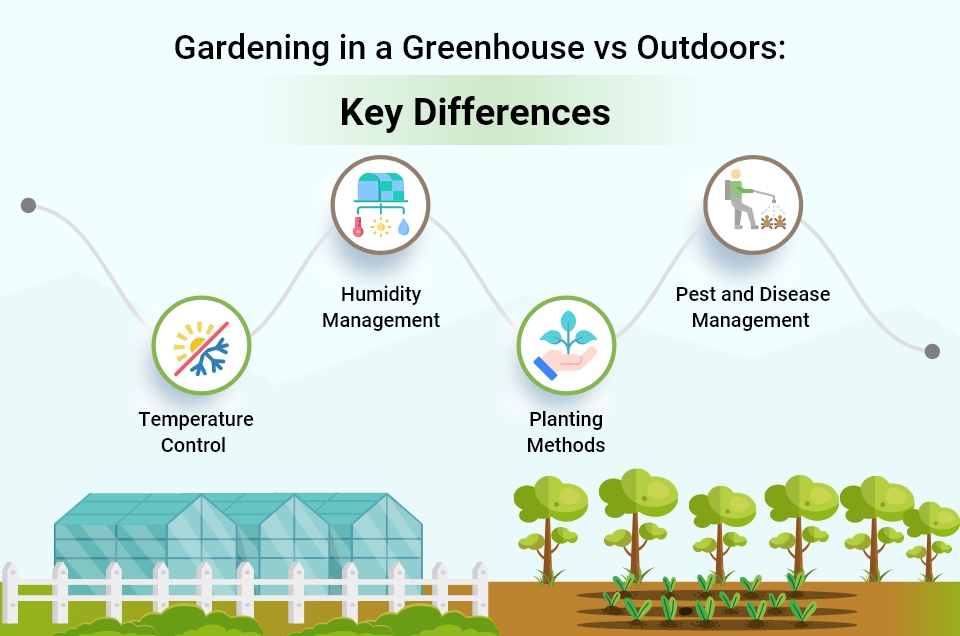
If you’ve mastered outdoor gardening, moving into the greenhouse will typically be an easy transition. However, there are some key differences to keep in mind:
1. Temperature Control
Greenhouses trap sunlight, and they get hot. But this is also an advantage compared to outdoor gardening.
The enclosed structure minimizes heat loss at night, allowing for greater temperature control compared to outdoors. (Earlier start in spring, especially for your nightshades and peppers!)
2. Humidity Management
Higher temperatures and reduced airflow in greenhouses can lead to increased humidity. Unlike outdoor gardens where humidity fluctuates naturally, greenhouse humidity needs monitoring and management.
Good ventilation and proper watering practices are essential to prevent fungal diseases that thrive in high humidity environments.
3. Planting Methods
In a lot of greenhouses, container gardening is popular. This makes it easier to water, so the type of soil you use will be looser and well-draining compared to outdoors.
Some greenhouses are installed directly over bare ground, however. This method would be like outdoor gardening. The key here is pest control. If your greenhouse has a bare floor, monitor regularly for pests and make sure they aren’t entering the greenhouse through the soil.
4. Pest and Disease Management
While protected from some outdoor pests, close monitoring for insects, mites, and fungal diseases is important for maintaining a healthy greenhouse environment.
Some of the most common greenhouse diseases and pests to watch for include:
- Fungal Diseases: The warm, humid conditions in greenhouses are ideal for fungal growth. Powdery mildew, botrytis (gray mold), and root rot are common problems.
- Bacterial Diseases: Bacteria can also thrive in greenhouses, causing problems like wilts and soft rots.
- Viruses: Some pests, like aphids and thrips, can spread viruses between plants in a greenhouse setting. Viral infections can be devastating and often have no cure.
Preventing greenhouse pests and diseases is all about creating a healthy environment for your plants and minimizing opportunities for invaders. This means practicing good sanitation by cleaning and disinfecting your greenhouse regularly, maintaining proper ventilation and humidity levels, and choosing disease-resistant plants.
What Plants to Grow in the Greenhouse Throughout the Year
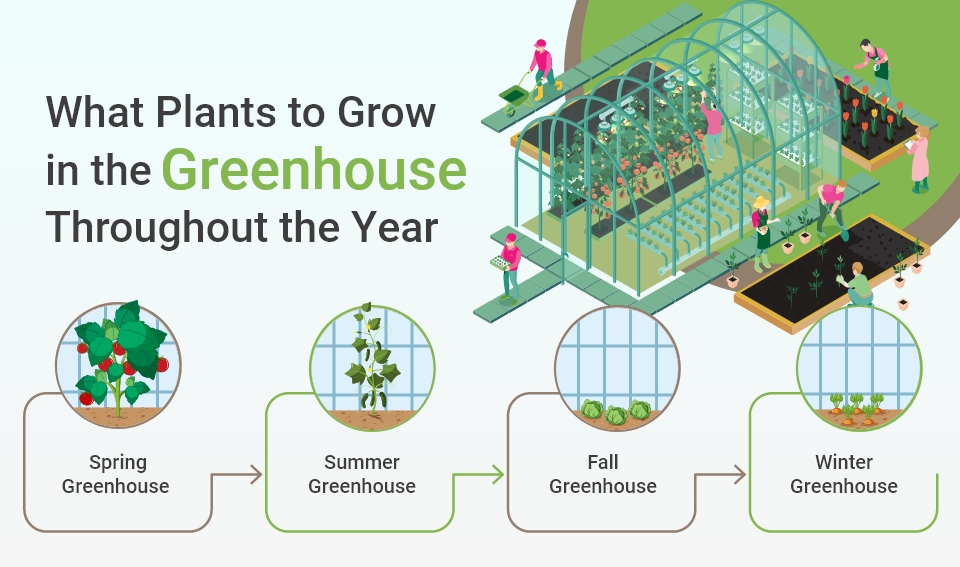
Most gardeners use a three-season greenhouse.
This means they can get a jumpstart in spring and extend the growing season further into the fall. But during winter, overnight temperatures in the greenhouse are typically too low to support plants.
Generally, though, a greenhouse will get lots of use throughout the year. Here are some quick ideas to get you started:
I. Spring Greenhouse
Spring is the prime time for seed starting in a greenhouse. You can get a head start on warm season crops like tomatoes, peppers, eggplants, and cucumbers by planting seeds indoors weeks before the safe planting date outdoors.
You can also use your greenhouse as a nursery for nurturing transplants that’ll you’ll move outdoors later.
The controlled environment protects them from unpredictable outdoor weather fluctuations and allows them to thrive. A greenhouse is particularly useful if you have windy, cold and rainy spring seasons.
II. Summer Greenhouse
In summer, the greenhouse can get very hot. It’s an ideal environment for heat-loving crops.
Tomatoes, eggplant and peppers are my go-to greenhouse crops. Greenhouse-grown peppers and tomatoes for example will fast outpace those grown outdoors. (My peppers are monsters!) Cucumbers also work well if you have a trellis and love the indoor temps.
In late summer, you can also use the greenhouse to start fall transplants. However, be aware that it can be hard to start seeds in summer, as generally, most seeds won’t germinate if temperatures exceed 85-90 degrees.
III. Fall Greenhouse
As outdoor temperatures dip, your greenhouse can become a sanctuary for extending the harvest of cool-weather crops like lettuce, spinach, kale, and arugula.
These plants can continue to grow happily throughout the fall (if temperatures stay above about 40 degrees in the greenhouse).
IV. Winter Greenhouse
For ambitious gardeners, a greenhouse with proper environmental controls can become a haven for year-round production. Here’s what winter greenhouse gardening entails:
- Climate Control: Heating and cooling systems allow you to maintain optimal temperatures for your chosen plants regardless of the outside season.
- Supplemental Lighting: During winter months with shorter days, artificial lights can be used to extend daylight hours and ensure your plants receive sufficient light for proper growth.
- Ventilation: Maintaining proper ventilation is still crucial year-round to prevent humidity buildup and fungal diseases.
Then, typically in March, you can use the greenhouse to start garden veggies and flowers with a long germination process. For example, thyme and rosemary, lavender, and peppers can all be started in late winter in the greenhouse.
Wrapping Up
I’m so glad I started greenhouse gardening. Since my first mini greenhouse, I’ve had the chance to work in the Homegrown Outlet test greenhouses and have gained a lot of experience.
A few things I would suggest: Start small. Although we all dream of a commercial greenhouse with all the bells and whistles, a lean-to, mini greenhouse or cold frame is a great way to extend the growing season (without breaking the bank). Then, once you’re ready, invest in a quality greenhouse.
Cheaper models might seem like a good deal. But you need something that will withstand the elements and snow loads. It’s better to spend more now, than to have to reinvest in a couple of years.
Visit a Homegrown Outlet location near you in New York. We offer the best selection of organic growing and hydroponic growing supplies in the region.
FAQs
Greenhouses are fantastic for extending your growing season and enjoying a wider variety of plants. However, they require some investment and ongoing maintenance. Consider your available space, budget, and commitment level. If you're short on space or just starting out, cold frames or row covers might be a good first step.
Sunlight is key! Look for a location with at least 6 hours of direct sunlight daily, ideally with an east-west orientation to maximize sun exposure. Avoid areas with constant shade or cold air pockets. Remember, good access for watering, ventilation adjustments, and harvesting is important too!
Think of ventilation as your greenhouse's breathing room. It helps regulate temperature by releasing hot air and prevents humidity build-up, which can lead to disease. Aim for good air circulation by having vents on opposite sides of your greenhouse.
Yes, it can! Proper ventilation is crucial, but you might also consider shade cloth for the afternoon sun or installing an automated ventilation system for peace of mind.
Tomatoes, peppers, cucumbers, herbs like basil and oregano, and leafy greens like lettuce and spinach are all great choices. They're relatively low-maintenance and provide a rewarding harvest.
Start with healthy plants and practice good sanitation by cleaning your greenhouse regularly. Proper ventilation and humidity control are key. Choose disease-resistant varieties and keep an eye out for early signs of trouble. For organic control, insecticidal soap or neem oil can be helpful against some pests.

